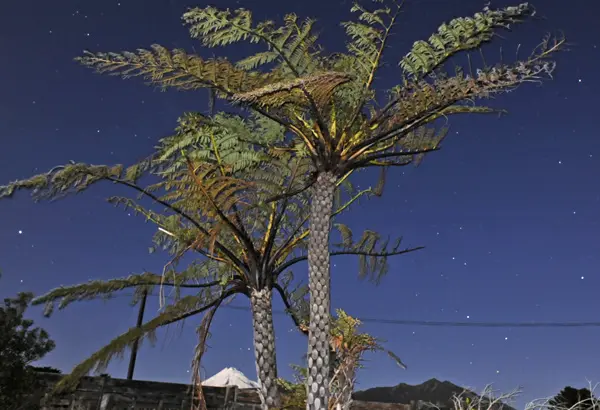56. Tree ferns and moonlit mountain, Koru Rd
December 26, 2010 4:16 pm

With my moonlight photography I have been experimenting lately with fill-in lighting, either flash or LED torchlight. Although their effects are different, they have in common the daylight colours achieved. Using mainly 30-second shutter times (the last choice before the B setting) I have enjoyed getting photos such as this one. It’s an unpredictable combination of instanteous flash and long exposure, taken on the 28mm lens at f11, on ISO 2000.
Here by the side of a country road southwest of New Plymouth, these botanical signposts of high rainfall appear starkly against the night sky. They loom above fresh snow on Mt Taranaki, which is lit up by the full moon. This is a whole new subset of moonlight photography, where once you have focus the technical difficulties relate to the strength of the flash and how you deploy it. Being something of a minimalist myself, without a separate flashgun, the illumination here comes straight off the camera. It was set off only once, at the beginning of the exposure, so there was no opportunity for side-lighting.
The usual issue is how the flash balances with the ambient moonlight. Getting the right exposure illuminates the fern quite effectively against the semi-night effect of snow and stars, but it is achieved by trial and error. The degree of illumination depends on just two variables: the distance from the flash to the foreground elements, and your ISO setting. So if you don’t want to move the tripod closer or further away, for this type of photo your main control is in the ISO setting, which you change to adjust for the flash result being too bright or too dark.
Only a small aperture was required for this effect, assisting depth of focus, although truth be told, the autofocus failed – and so I no longer bother with it, relying on a manual focus setting instead.
Posted by Barney Brewster
Tags: focus, high ISO, long exposure, moonlight, moonlight photography, mountain, New Plymouth, Nikon D700, stars, Taranaki, tripod, wide angle
Categories: Night photography
